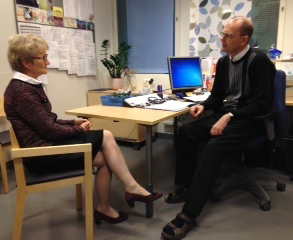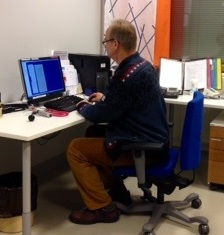From the President: Primary Health Care Reform in Finland

GPs Dr Kaisa Nissinen-Paatsalmala, Medical Director, and Dr Ragnar Ulfvens in a typical GP consulting room at the Myllypuro Health Station in East Helsinki
español
Midwinter is probably not the best time to visit Finland to see the sights. But it is a great time of year to meet with many of our colleagues in family medicine from across the country as they converge on Helsinki for the annual General Practice Finland Conference.
This was my first visit to Finland, a country which has fascinated me since I was five years old and my mother first introduced me to the magical books of Tove Jansen about the Moomins.
 Photo: GP Dr Arto Virtanen catching up on his electronic prescription requests at the Nurmijarvi Health Center in rural Finland
Photo: GP Dr Arto Virtanen catching up on his electronic prescription requests at the Nurmijarvi Health Center in rural Finland
Finland has a population of 5.5 million and a reputation for providing universal health coverage (government-subsidised health care to all citizens regardless of their ability to pay) and a strong track record on the adoption of electronic medical records in general practice to improve the quality and safety of primary health care.
The Government of Finland has determined that healthcare and social care services will be run by the same government department, which allows for some streamlining of care provision. Finland also has a strong system of general practice run through public clinics, as well as through private services.
 Photo: WONCA President with general practice colleagues, researchers and teachers in Helsinki
Photo: WONCA President with general practice colleagues, researchers and teachers in Helsinki
I was impressed to learn that Finnish general practitioners not only keep all their own medical records on computers but they also have access to full hospital and specialist electronic records and to radiology and pathology results ordered anywhere in the country. This is an achievement which remains beyond the reach of many other developed nations. Finland also has a strong history of embedding clinical guidelines into electronic medical records to assist general practitioners (GPs) in incorporating evidence-based medicine into their daily work with their patients.
There are of course challenges, not least with the funding of public general practice in Finland. Each local government municipality in Finland has responsibility for funding its local health centres, which risks discrepancies between services.
And only 3,500 of the 20,000 doctors in Finland are GPs. This places a huge strain on primary care services. Up to 30% of all Finnish GPs work in rural areas ensuring equitable access to health services for the entire population, including those living in the northern areas of Lappland.

Photo: Downtown Helsinki with the remarkable wooden “Chapel of Quiet Contemplation”
In Helsinki there are 25 publicly-funded health stations staffed by teams of GPs and primary care nurses. The members of the population are free to choose which health station they will utilize, and can also choose their own personal GP-nurse pair for their continuing health care. The public health stations also include self-treatment areas where patients can take their own blood pressure and monitor other aspects of their own health and fitness. And each health station also includes specialized services in mental health, substance use and oral health, as well as separate maternity and child health clinics. The health clinics are supported by a telephone consultation service, operated by nurses, which triages access to GPs.
 Photo: Helsinki waterside
Photo: Helsinki waterside
There are of course, many challenges. Waiting times for first appointments can be lengthy. Recruiting excellent doctors to work in the public sector GP clinics can be difficult, with many doctors choosing to work in private general practice. And the health system has an over-reliance on specialized care, which has resulted in relative underinvestment in primary care. Postgraduate specialized training in family medicine is available but is not compulsory for those chossing to work in general practice. These are common challenges facing family medicine in many countries.
Finland also has strong academic family medicine through the Departments of General Practice at each of the nation’s five medical schools (in Helsinki, Turku, Tampere, Kuopio and Oulu, in the far north). And every medical graduate in Finland spends up to 9 months immediately after graduation, working as a resident in general practice under the supervision of GPs.
Update on Ebola response
Dr Atai Amaruto, an active member with WONCA’s working party on women in family medicine, is set to return home to Uganda after providing many weeks of meritorious voluntary service in Liberia, working alongside colleagues from around the world in helping with the fight against Ebola Virus. Atai recently drew world media attention to a trend of the wives of some of the healed and discharged men apparently contracted the disease from their husbands and presenting with infection. The World Health Organization recommends that men avoid sexual intercourse for at least seven weeks after recovery, or wear condoms if having sexual intercourse during the first seven weeks after recovery. Ebola is sexually transmissible and this reinforces the need for the use of condoms or abstinence for those who have survived infection.
Michael Kidd
WONCA President